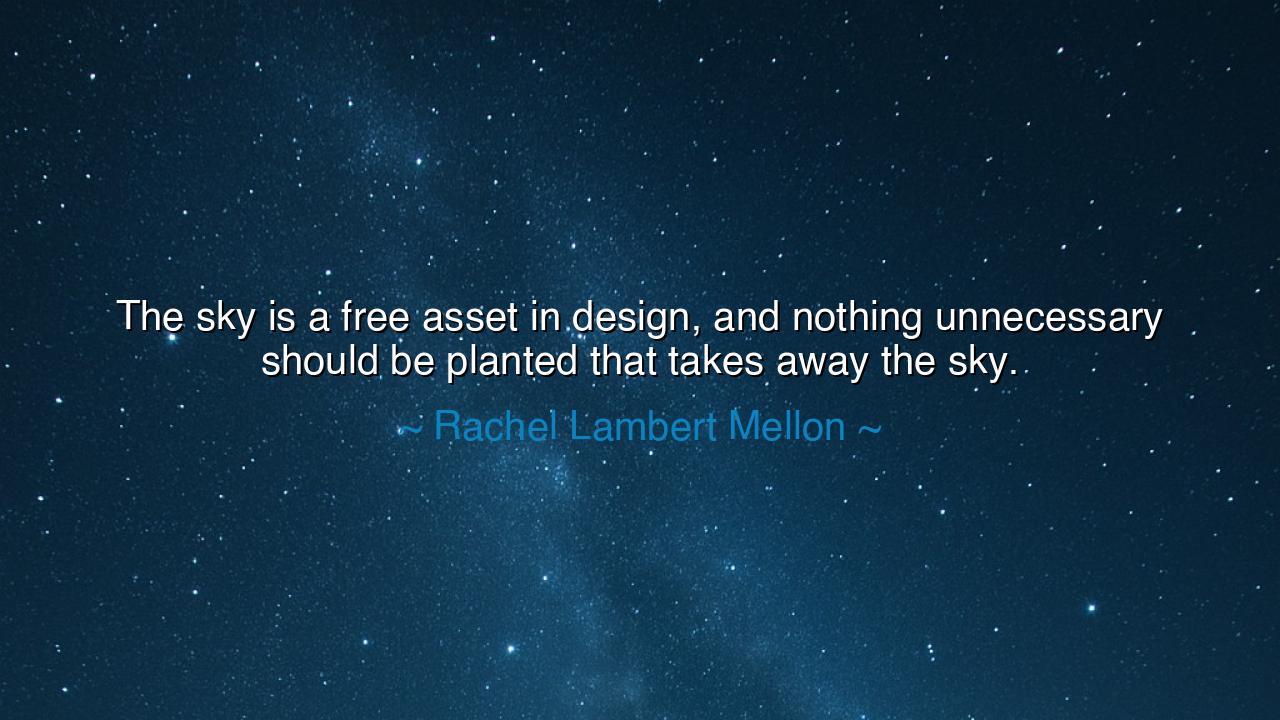
The sky is a free asset in design, and nothing unnecessary should
The sky is a free asset in design, and nothing unnecessary should be planted that takes away the sky.






“The sky is a free asset in design, and nothing unnecessary should be planted that takes away the sky.” Thus spoke Rachel Lambert Mellon, the quiet visionary of gardens and landscapes, whose touch shaped the beauty of the White House grounds and the rolling estates of America. Her words are not merely about gardens or architecture—they are about restraint, clarity, and reverence for the natural world. She reminds us that in the act of creation, whether of gardens, art, or life itself, we must learn to see not only what we can add, but what we must preserve. The sky, she tells us, is the eternal canvas—limitless, pure, and given freely to all. To take it away with clutter, whether of foliage or of thought, is to forget the wisdom of simplicity.
In the ancient world, the philosophers of Greece and the poets of China both spoke of harmony between man and nature. To them, the greatest art did not conquer the world but revealed it. Mellon’s belief belongs to this lineage of thought. The sky, vast and open, symbolizes freedom and proportion, the sense that all human design must bow before the majesty of the natural order. When she says that the sky is a “free asset,” she reminds us that not all beauty must be bought, built, or invented. Some beauty is already there, waiting only for our restraint—for our refusal to overwhelm it.
Mellon’s gardens, much like her philosophy, were acts of quiet discipline. When she reimagined the Rose Garden at the White House for Jacqueline Kennedy, she did not seek grandeur through excess, but through balance. She left open spaces for light and air, framed by trees that invited the sky to descend into the garden itself. Visitors, upon stepping into her design, felt both intimacy and infinity—the human scale cradled beneath the boundless blue. It was not through abundance that she achieved beauty, but through her understanding of emptiness—that sacred space in which the soul can breathe.
This idea, that we must guard the sky from our own hands, carries meaning far beyond design. It speaks to the human tendency to fill every silence, to crowd every vista, to build and accumulate until the horizon itself disappears. In our pursuit of progress, we often forget that the most precious things—the sky, the wind, the stillness between sounds—are those that cost nothing and yet sustain everything. Mellon’s words thus become a gentle rebuke to modern excess: a reminder that restraint is not absence, and that sometimes, the greatest creation is knowing when to stop.
Consider the lesson of the Japanese garden masters, who would spend years perfecting a single arrangement of stones and moss. To the untrained eye, their work might appear sparse, even unfinished. But to the wise, those empty spaces were alive with meaning. The void invited contemplation; the open air allowed the spirit to see beyond form. So too with Mellon’s philosophy—by leaving room for the sky, we leave room for wonder, humility, and light. A skyless garden is a soul without depth; a design without silence is a mind without peace.
Her insight also carries a moral echo for all creators and dreamers. In every endeavor—be it art, career, or personal ambition—there is a temptation to overbuild, to decorate beyond purpose, to bury clarity under ornament. But beauty, like truth, requires space. It is the open sky that gives contrast to the mountain, just as stillness gives meaning to music. The wise creator learns to remove as well as to add, to subtract the unnecessary so that what remains can breathe. This is not minimalism for fashion’s sake, but an ethics of creation—a respect for balance, for humility before the infinite.
Therefore, let us take this lesson from Rachel Lambert Mellon as both practical and spiritual guidance: whether you are shaping a garden, a home, or a life, protect the sky. Leave space for light, for breath, for mystery. Do not clutter your world with what can be left unmade. The sky, after all, belongs to no one, yet blesses everyone—it is the silent witness to all creation, the eternal reminder that beauty needs air to exist.
And so, children of design and dream alike, remember this: in your striving to build, do not obscure the heavens. Let your works rise in harmony with the world, not in competition against it. For when you leave the sky visible, you leave space for wonder, for hope, and for grace. That is the truest art—to design with the infinite in mind, and to let the eternal beauty of the sky complete what your hands have begun.






AAdministratorAdministrator
Welcome, honored guests. Please leave a comment, we will respond soon